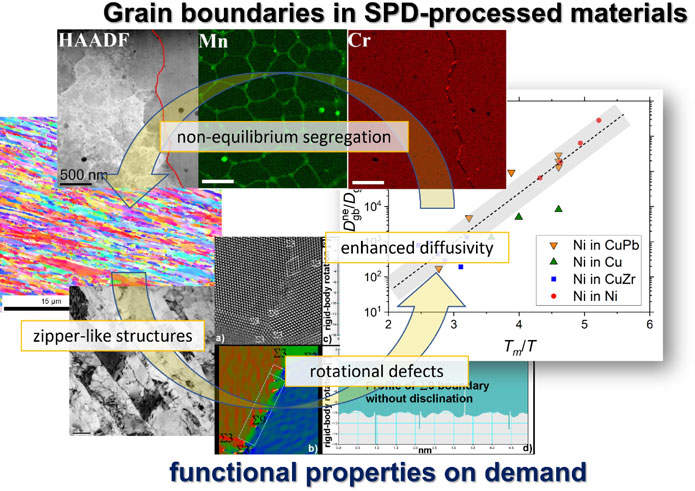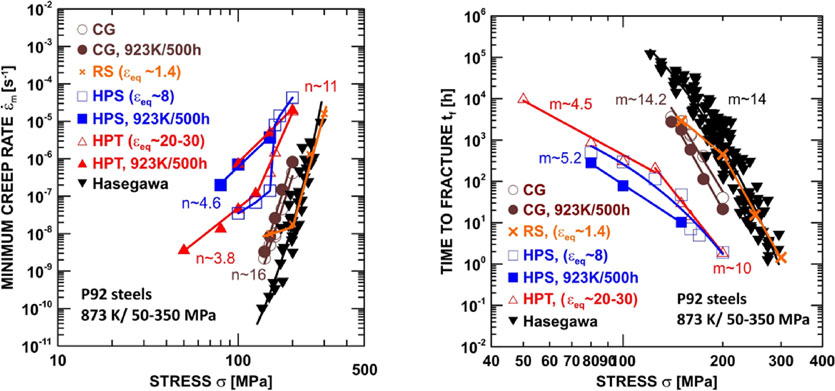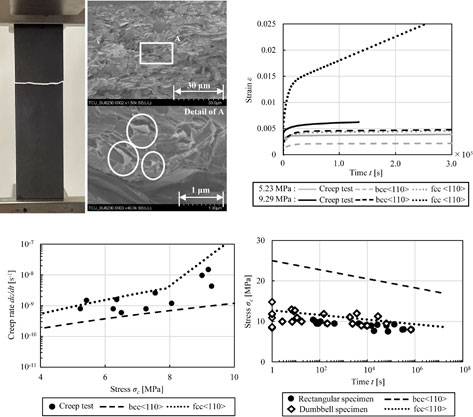Volume 64, Issue 7
Displaying 1-40 of 40 articles from this issue
- |<
- <
- 1
- >
- >|
Special Issue on Superfunctional Nanomaterials by Severe Plastic Deformation
-
Article type: Preface
Subject area: Special Issue on Superfunctional Nanomaterials by Severe Plastic Deformation
2023Volume 64Issue 7 Pages 1271
Published: July 01, 2023
Released on J-STAGE: June 25, 2023
Download PDF (33K) Full view HTML -
Article type: Overview
Subject area: Special Issue on Superfunctional Nanomaterials by Severe Plastic Deformation
2023Volume 64Issue 7 Pages 1272-1283
Published: July 01, 2023
Released on J-STAGE: June 25, 2023
Advance online publication: February 17, 2023Download PDF (1554K) Full view HTML -
Article type: Overview
Subject area: Special Issue on Superfunctional Nanomaterials by Severe Plastic Deformation
2023Volume 64Issue 7 Pages 1284-1298
Published: July 01, 2023
Released on J-STAGE: June 25, 2023
Advance online publication: March 17, 2023Download PDF (3511K) Full view HTML -
Article type: Overview
Subject area: Special Issue on Superfunctional Nanomaterials by Severe Plastic Deformation
2023Volume 64Issue 7 Pages 1299-1305
Published: July 01, 2023
Released on J-STAGE: June 25, 2023
Advance online publication: April 07, 2023Download PDF (2617K) Full view HTML -
Article type: Overview
Subject area: Special Issue on Superfunctional Nanomaterials by Severe Plastic Deformation
2023Volume 64Issue 7 Pages 1306-1316
Published: July 01, 2023
Released on J-STAGE: June 25, 2023
Download PDF (8077K) Full view HTML -
Article type: Overview
Subject area: Special Issue on Superfunctional Nanomaterials by Severe Plastic Deformation
2023Volume 64Issue 7 Pages 1317-1324
Published: July 01, 2023
Released on J-STAGE: June 25, 2023
Advance online publication: March 31, 2023Download PDF (2809K) Full view HTML -
Article type: Overview
Subject area: Special Issue on Superfunctional Nanomaterials by Severe Plastic Deformation
2023Volume 64Issue 7 Pages 1325-1330
Published: July 01, 2023
Released on J-STAGE: June 25, 2023
Download PDF (1716K) Full view HTML -
Article type: Overview
Subject area: Special Issue on Superfunctional Nanomaterials by Severe Plastic Deformation
2023Volume 64Issue 7 Pages 1331-1345
Published: July 01, 2023
Released on J-STAGE: June 25, 2023
Advance online publication: March 31, 2023Download PDF (9251K) Full view HTML -
Article type: Overview
Subject area: Special Issue on Superfunctional Nanomaterials by Severe Plastic Deformation
2023Volume 64Issue 7 Pages 1346-1352
Published: July 01, 2023
Released on J-STAGE: June 25, 2023
Advance online publication: March 31, 2023Download PDF (3136K) Full view HTML -
Article type: Overview
Subject area: Special Issue on Superfunctional Nanomaterials by Severe Plastic Deformation
2023Volume 64Issue 7 Pages 1353-1363
Published: July 01, 2023
Released on J-STAGE: June 25, 2023
Advance online publication: April 28, 2023Download PDF (9330K) Full view HTML -
Article type: Overview
Subject area: Special Issue on Superfunctional Nanomaterials by Severe Plastic Deformation
2023Volume 64Issue 7 Pages 1364-1375
Published: July 01, 2023
Released on J-STAGE: June 25, 2023
Advance online publication: April 07, 2023Download PDF (8739K) Full view HTML -
Article type: Overview
Subject area: Special Issue on Superfunctional Nanomaterials by Severe Plastic Deformation
2023Volume 64Issue 7 Pages 1376-1386
Published: July 01, 2023
Released on J-STAGE: June 25, 2023
Advance online publication: April 14, 2023Download PDF (5052K) Full view HTML -
Article type: Overview
Subject area: Special Issue on Superfunctional Nanomaterials by Severe Plastic Deformation
2023Volume 64Issue 7 Pages 1387-1400
Published: July 01, 2023
Released on J-STAGE: June 25, 2023
Advance online publication: April 14, 2023Download PDF (6810K) Full view HTML -
Article type: Overview
Subject area: Special Issue on Superfunctional Nanomaterials by Severe Plastic Deformation
2023Volume 64Issue 7 Pages 1401-1409
Published: July 01, 2023
Released on J-STAGE: June 25, 2023
Advance online publication: April 21, 2023Download PDF (5760K) Full view HTML -
Article type: Overview
Subject area: Special Issue on Superfunctional Nanomaterials by Severe Plastic Deformation
2023Volume 64Issue 7 Pages 1410-1418
Published: July 01, 2023
Released on J-STAGE: June 25, 2023
Download PDF (6213K) Full view HTML -
Article type: Overview
Subject area: Special Issue on Superfunctional Nanomaterials by Severe Plastic Deformation
2023Volume 64Issue 7 Pages 1419-1428
Published: July 01, 2023
Released on J-STAGE: June 25, 2023
Advance online publication: April 28, 2023Download PDF (3895K) Full view HTML -
Article type: Overview
Subject area: Special Issue on Superfunctional Nanomaterials by Severe Plastic Deformation
2023Volume 64Issue 7 Pages 1429-1440
Published: July 01, 2023
Released on J-STAGE: June 25, 2023
Download PDF (4307K) Full view HTML -
Article type: Overview
Subject area: Special Issue on Superfunctional Nanomaterials by Severe Plastic Deformation
2023Volume 64Issue 7 Pages 1441-1448
Published: July 01, 2023
Released on J-STAGE: June 25, 2023
Download PDF (4629K) Full view HTML -
Article type: Overview
Subject area: Special Issue on Superfunctional Nanomaterials by Severe Plastic Deformation
2023Volume 64Issue 7 Pages 1449-1463
Published: July 01, 2023
Released on J-STAGE: June 25, 2023
Download PDF (10080K) Full view HTML -
Article type: Overview
Subject area: Special Issue on Superfunctional Nanomaterials by Severe Plastic Deformation
2023Volume 64Issue 7 Pages 1464-1473
Published: July 01, 2023
Released on J-STAGE: June 25, 2023
Advance online publication: May 12, 2023Download PDF (3392K) Full view HTML -
Article type: Overview
Subject area: Special Issue on Superfunctional Nanomaterials by Severe Plastic Deformation
2023Volume 64Issue 7 Pages 1474-1488
Published: July 01, 2023
Released on J-STAGE: June 25, 2023
Advance online publication: May 12, 2023Download PDF (9776K) Full view HTML -
Article type: Overview
Subject area: Special Issue on Superfunctional Nanomaterials by Severe Plastic Deformation
2023Volume 64Issue 7 Pages 1489-1496
Published: July 01, 2023
Released on J-STAGE: June 25, 2023
Advance online publication: May 12, 2023Download PDF (5357K) Full view HTML -
Article type: Review
Subject area: Special Issue on Superfunctional Nanomaterials by Severe Plastic Deformation
2023Volume 64Issue 7 Pages 1497-1503
Published: July 01, 2023
Released on J-STAGE: June 25, 2023
Download PDF (2386K) Full view HTML -
Article type: Review
Subject area: Special Issue on Superfunctional Nanomaterials by Severe Plastic Deformation
2023Volume 64Issue 7 Pages 1504-1514
Published: July 01, 2023
Released on J-STAGE: June 25, 2023
Advance online publication: May 12, 2023Download PDF (6910K) Full view HTML -
Article type: Review
Subject area: Special Issue on Superfunctional Nanomaterials by Severe Plastic Deformation
2023Volume 64Issue 7 Pages 1515-1525
Published: July 01, 2023
Released on J-STAGE: June 25, 2023
Advance online publication: March 31, 2023Download PDF (5930K) Full view HTML -
Article type: Review
Subject area: Special Issue on Superfunctional Nanomaterials by Severe Plastic Deformation
2023Volume 64Issue 7 Pages 1526-1536
Published: July 01, 2023
Released on J-STAGE: June 25, 2023
Advance online publication: April 14, 2023Download PDF (5175K) Full view HTML -
Article type: Review
Subject area: Special Issue on Superfunctional Nanomaterials by Severe Plastic Deformation
2023Volume 64Issue 7 Pages 1537-1550
Published: July 01, 2023
Released on J-STAGE: June 25, 2023
Advance online publication: April 14, 2023Download PDF (8303K) Full view HTML -
Article type: Review
Subject area: Special Issue on Superfunctional Nanomaterials by Severe Plastic Deformation
2023Volume 64Issue 7 Pages 1551-1565
Published: July 01, 2023
Released on J-STAGE: June 25, 2023
Advance online publication: April 14, 2023Download PDF (9944K) Full view HTML -
Article type: Review
Subject area: Special Issue on Superfunctional Nanomaterials by Severe Plastic Deformation
2023Volume 64Issue 7 Pages 1566-1574
Published: July 01, 2023
Released on J-STAGE: June 25, 2023
Advance online publication: April 21, 2023Download PDF (786K) Full view HTML -
Article type: Review
Subject area: Special Issue on Superfunctional Nanomaterials by Severe Plastic Deformation
2023Volume 64Issue 7 Pages 1575-1584
Published: July 01, 2023
Released on J-STAGE: June 25, 2023
Advance online publication: May 12, 2023Download PDF (4435K) Full view HTML -
Article type: Regular Article
Subject area: Special Issue on Superfunctional Nanomaterials by Severe Plastic Deformation
2023Volume 64Issue 7 Pages 1585-1590
Published: July 01, 2023
Released on J-STAGE: June 25, 2023
Advance online publication: March 17, 2023Download PDF (3556K) Full view HTML
Regular Article
Microstructure of Materials
-
Article type: Regular Article
2023Volume 64Issue 7 Pages 1591-1599
Published: July 01, 2023
Released on J-STAGE: June 25, 2023
Download PDF (5104K) Full view HTML
Mechanics of Materials
-
Article type: Regular Article
2023Volume 64Issue 7 Pages 1600-1604
Published: July 01, 2023
Released on J-STAGE: June 25, 2023
Advance online publication: May 12, 2023Download PDF (2273K) Full view HTML -
Article type: Regular Article
2023Volume 64Issue 7 Pages 1605-1613
Published: July 01, 2023
Released on J-STAGE: June 25, 2023
Download PDF (3512K) Full view HTML -
Article type: Regular Article
2023Volume 64Issue 7 Pages 1614-1621
Published: July 01, 2023
Released on J-STAGE: June 25, 2023
Advance online publication: May 12, 2023Download PDF (2551K) Full view HTML -
Article type: Regular Article
2023Volume 64Issue 7 Pages 1622-1630
Published: July 01, 2023
Released on J-STAGE: June 25, 2023
Advance online publication: April 21, 2023Download PDF (7364K) Full view HTML -
Article type: Regular Article
2023Volume 64Issue 7 Pages 1631-1637
Published: July 01, 2023
Released on J-STAGE: June 25, 2023
Advance online publication: May 12, 2023Download PDF (3876K) Full view HTML
Materials Processing
-
Article type: Regular Article
2023Volume 64Issue 7 Pages 1638-1644
Published: July 01, 2023
Released on J-STAGE: June 25, 2023
Download PDF (4898K) Full view HTML -
Article type: Regular Article
2023Volume 64Issue 7 Pages 1645-1654
Published: July 01, 2023
Released on J-STAGE: June 25, 2023
Advance online publication: April 21, 2023Download PDF (10218K) Full view HTML -
Article type: Regular Article
2023Volume 64Issue 7 Pages 1655-1662
Published: July 01, 2023
Released on J-STAGE: June 25, 2023
Download PDF (4632K) Full view HTML
- |<
- <
- 1
- >
- >|




































